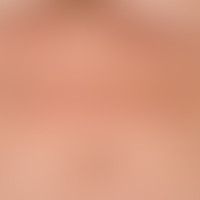Dyskeratosis follicularis Images
Go to article Dyskeratosis follicularis
Dyskeratosis follicularis: densely packed brown-reddish papules, about 2-4 mm in size, which aggregate in the décolleté area; the present distribution pattern suggests a light provocation of the disease.

Dyskeratosis follicularis (Darier's disease) Disseminated, yellow-brownish papules and plaques, sometimes covered with small crusts.

Dyskeratosis follicularis: Large, hyperkeratotic zones existing since early childhood with reddish, partly macerated papules and firmly adhering, partly eroded, confluent keratoses on the capillitium of a 74-year-old woman.

Dyskeratosis follicularis: 74-year-old woman. large , hyperkeratotic zones with reddish, partly macerated papules and firmly adhering, partly eroded, confluent keratoses on the capillitium and in the facial area preauricularly, existing since early childhood. the patient has a somewhat neglected appearance. the skin lesions have a foetal odour. the lesions increase with sweating or heat, especially in the warm season.


Dyskeratosis follicularis: disseminated, chronically stationary, 0.1-0.2 cm in size, flatly elevated, moderately firm, non-itching, rough, red, scaly papules which unite at the top to form a blurred plaque; skin lesions have existed in varying degrees in this 53-year-old patient for several years.

Dyskeratosis follicularis (Darier's disease): non-itching, chronically persistent, disseminated papules.




Dyskeratosis follicularis (Darier's disease). acuteprovocation of the disease after light dermatitis solaris. no symptoms in areas not exposed to sunlight.

dyskeratosis follicularis. presentation of multiple, chronically stationary, disseminated, red nbis rfot-brown papules localized in the submammary and upper abdomen. in these areas strong increase of skin changes, especially in summer with increased sweating.

Dyskeratosis follicularis (Darier's disease).

Dyskeratosis follicularis. presentation of multiple, chronically stationary, intertriginously localized, submammary, disseminated, highly itchy, red papules. in these areas, a strong increase in skin changes, especially in summer with increased sweating.

Dyskeratosis follicularis: multiple, disseminated, chronically inpatient, 0.1-0.2 cm large, flatly elevated, moderately firm, non-itching, rough, red, scaly papules, which combine at the top to form a blurred plaque; skin lesions have existed in this 55 year old patient for several years.

Dyskeratosis follicularis: disseminated, chronically stationary, 0.1-0.2 cm in size, intermamillary localized, flatly elevated, moderately firm, non-itching, rough, red, scaly papules which unite at the top to form a blurred plaque; skin lesions have existed in varying degrees in this 53-year-old patient for several years.

Dyskeratosis follicularis (Darier's disease).




Dyskeratosis follicularis: Infestation of the palms of the hands; in central areas of the palm flat, common keratoses, at the ball of the thumb about 0.1-0.2 cm large, glassy papules.

Dyskeratosis follicularis (Darier's disease) : Approximately 0.3-0.4 cm in size, disseminated, yellow-brown, little scaling papules and plaques.

Dyskeratosis follicularis, overview: Multiple, chronically dynamic, intertriginously localized, whitish, rough, flatly aggregated, marrowy, itchy plaques in both popliteal fossa.


Dyskeratosis follicularis (Darier's disease). Disseminated red to reddish-brown papules and plaques, in places also indicated in a striated arrangement. No significant scaling, isolated erosive papules.

Chronicdyskeratosis follicularis, also affecting the Rima ani (see detailed picture), intertriginous, whitish and red-brownish sooty, blurred, macerated, superficially rough, clearly increased in consistency, itchy and unpleasantly smelling plaques.

Dyskeratosis follicularis. infestation of the Rima ani. chronic, intertriginous, whitish sooty, blurred, macerated, superficially rough, clearly increased in consistency, itchy and unpleasant smelling plaques. peripherally the characteristic picture of dyskeratosis follicularis with disseminated red or red-brown papules. on the left side 2 melanocytic nevi.

Dyskeratosis follicularis: Papules and dirty-brownish crusts of a zosteriform-striary dyskeratosis follicularis in the course of the blaschkolines in the upper abdomen and flanks in a 5-year-old girl.


Dyskeratosis follicularis. reflected light microscopy: section of a lesion on the neck. yellowish-white keratin plaques (orthohyperkeratosis) and areas with ball-shaped, ectatic central capillaries (acantholysis area).

Dyskeratosis follicularis: less symptomatic, partly isolated, partly areal aggregated papules of the anal region; occasional maceration and malodorous

Onychodystrophy with dyskeratosis follicularis: Different nail changes.






